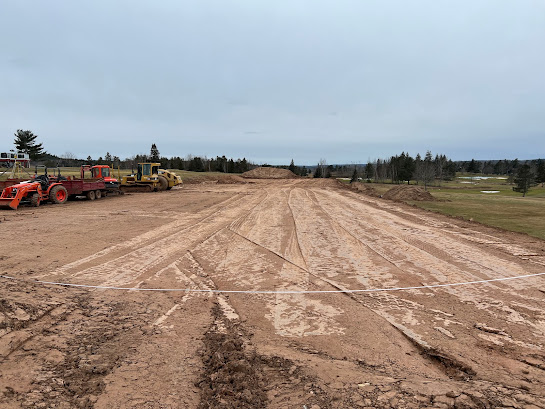The decision was made last year that a major renovation to our driving range was to take place. The previous natural grass teeing area needed improvement. The tee deck was too small for extended periods of play and the quality of turf itself was less than ideal after decades of use. The lower grass tee deck was much smaller and would be almost unusable after a week or less of play. The idea was to strip the entire area, haul fill to where the lower tee deck was, and bring the grade up to that of the upper tee deck. We would also extend the tee deck over to where the teaching tee was. Previously we had in the neighborhood of 10,000ft2 of natural grass to hit from. When the renovation is complete, we will be just over 20,000ft2. We were able to source the fill from the right side of the driving range, which is stocked full of good clean soil. The area will be seeded upon completion in the spring.
Initially we were looking at seeding the tee with a bentgrass variety, similar to our work on 9 white/blue tee last season. While successful, growing in a tee from scratch by seed takes the better part of a season to reach a maturity level that could be played from. With the beating a driving range tee inevitably receives, sodding the tee was an option that quickly gained momentum. While bentgrass is the assumed choice for turf type, cost and availability for 20,000ft2 of bentgrass can be a significant issue. We have been working with Turf Masters for the construction of the tee deck. They have had success using a type of Kentucky bluegrass that can be mowed at lower height of cut. I have had experience using this variety of bluegrass in the past and have been happy with the results. It is a product that is available locally, and at a cheaper cost than bentgrass. For some more insight, please follow the link: https://greenhorizonssod.com/uploads/spec-sheets/dwarf-lowmow.pdf
We have been blessed with a winter that was largely free of snow for January and February. This allowed for much more progress of the construction to be completed whereas in most years we would not have been able to work on the golf course when snow and ice is present for longer stretches. We are much farther along than I imagined we would be at this point. Wet conditions in spring tend to delay construction projects as well so a normal year could see little work being able to be done until May.
We are also taking the opportunity to replace the artificial
mats on the range over the offseason. We will be using a premium product that
will help improve the practicing and warm up experience when the grass tees are
closed.



No comments:
Post a Comment